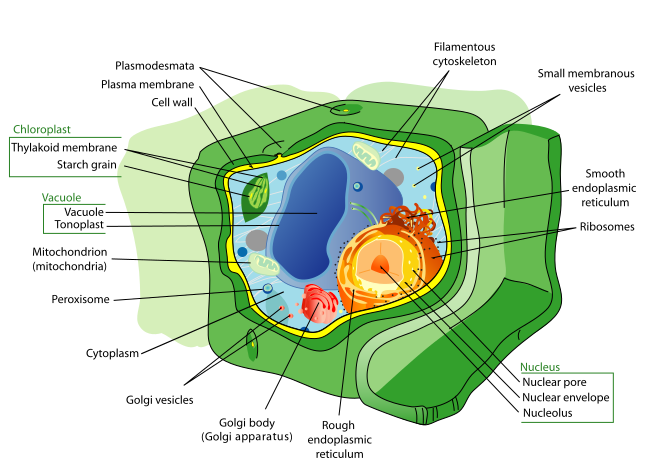
Draw the structure of a Eukaryotic cell (Plant cell)
Answer
479.4k+ views
Hint: Eukaryotic cells are cells with a nucleus enclosed inside the nuclear membrane. Examples for eukaryotic cells are protozoa, fungi, plants and animals. Eukaryotic cells are larger in size than prokaryotic cells.
Complete answer: The eukaryotic cell contains various organelles embedded in the cytoplasm and cytoplasm is enclosed by the plasma membrane.

a) Cell wall: The outermost layer in the plant cell is called the cell wall. The function of the cell wall is to provide rigidity and strength. It prevents the cell from bursting when water enters the cell during osmosis.
b) Plasma membrane: It is the phospholipid bilayer. The function of the plasma membrane is to allow transport. The plasma membrane is semi-permeable in nature i.e. it allows the certain substance to pass through it.
c) Vacuole: Large centrally located organelle is called the vacuole. It is a single membrane-bound organelle. The membrane of the vacuole is called tonoplast membrane.
d) Mitochondria: The double membrane-bound organelle. It is also called a powerhouse of the cell. It is the site for aerobic respiration and ATP synthesis. The inner membrane is called Cristae and fluid present in mitochondria is called matrix.
e) Chloroplast: Like that of mitochondria, it is a double-membrane organelle. It is the site of photosynthesis. The fluid present in the chloroplast is called the stroma.
f) Golgi apparatus: Stack like structure present in the cell. The function of Golgi is to modify protein and lipids.
g) Endoplasmic reticulum: Membranous structure is continuous with the nuclear membrane. If ribosome present on the surface it is RER i.e. Rough endoplasmic reticulum. If ribosomes are absent it is SER i.e. smooth endoplasmic reticulum.
h) Ribosome: Small granules present in the cytoplasm. It is the site for protein synthesis.
i) Lysosome: Organelle consists of hydrolytic enzymes.
j) Nucleus: Contains chromosome and DNA and a dense structure called nucleolus.
Note: Centrioles are the structure present only in animal cells and are absent in plant cells. The function of a centriole is to assist during cell division. The cell wall is absent in an animal cell and only the plasma membrane is present.
Complete answer: The eukaryotic cell contains various organelles embedded in the cytoplasm and cytoplasm is enclosed by the plasma membrane.

a) Cell wall: The outermost layer in the plant cell is called the cell wall. The function of the cell wall is to provide rigidity and strength. It prevents the cell from bursting when water enters the cell during osmosis.
b) Plasma membrane: It is the phospholipid bilayer. The function of the plasma membrane is to allow transport. The plasma membrane is semi-permeable in nature i.e. it allows the certain substance to pass through it.
c) Vacuole: Large centrally located organelle is called the vacuole. It is a single membrane-bound organelle. The membrane of the vacuole is called tonoplast membrane.
d) Mitochondria: The double membrane-bound organelle. It is also called a powerhouse of the cell. It is the site for aerobic respiration and ATP synthesis. The inner membrane is called Cristae and fluid present in mitochondria is called matrix.
e) Chloroplast: Like that of mitochondria, it is a double-membrane organelle. It is the site of photosynthesis. The fluid present in the chloroplast is called the stroma.
f) Golgi apparatus: Stack like structure present in the cell. The function of Golgi is to modify protein and lipids.
g) Endoplasmic reticulum: Membranous structure is continuous with the nuclear membrane. If ribosome present on the surface it is RER i.e. Rough endoplasmic reticulum. If ribosomes are absent it is SER i.e. smooth endoplasmic reticulum.
h) Ribosome: Small granules present in the cytoplasm. It is the site for protein synthesis.
i) Lysosome: Organelle consists of hydrolytic enzymes.
j) Nucleus: Contains chromosome and DNA and a dense structure called nucleolus.
Note: Centrioles are the structure present only in animal cells and are absent in plant cells. The function of a centriole is to assist during cell division. The cell wall is absent in an animal cell and only the plasma membrane is present.
Recently Updated Pages
Master Class 11 Economics: Engaging Questions & Answers for Success

Master Class 11 Business Studies: Engaging Questions & Answers for Success

Master Class 11 Accountancy: Engaging Questions & Answers for Success

Master Class 11 English: Engaging Questions & Answers for Success

Master Class 11 Computer Science: Engaging Questions & Answers for Success

Master Class 11 Maths: Engaging Questions & Answers for Success

Trending doubts
State and prove Bernoullis theorem class 11 physics CBSE

1 ton equals to A 100 kg B 1000 kg C 10 kg D 10000 class 11 physics CBSE

State the laws of reflection of light

One Metric ton is equal to kg A 10000 B 1000 C 100 class 11 physics CBSE

1 Quintal is equal to a 110 kg b 10 kg c 100kg d 1000 class 11 physics CBSE

Difference Between Prokaryotic Cells and Eukaryotic Cells




